'Serious' Games
Games can be applied and/or designed for many different purposes beyond entertainment. My research has included the design, development, and evaluation of games for purposes such as education, reflection, creativity, science, and more.
Prompt Override: LLM Hacking as Serious Game
Roberto Gallotta, Antonios Liapis, and Georgios N. Yannakakis

An in-game screenshot of Prompt Override showing the interactive file system explorer, the mission objectives and the chat interface with KARMA, the LLM player assistant.
Abstract: In this demo paper we present Prompt Override, a serious game in which players engage in prompt-based hacking challenges by manipulating the system prompt of a large language model (LLM) to solve puzzles. The game features two LLMs: one as the target of the player’s hacking attempts, and another as a rogue assistant guiding the player throughout the game. As players explore a simulated file system, editing prompt snippets, Prompt Override offers a unique take on the hacking game genre—one where rigid solution paths are replaced with more open-ended, language-driven problem solving. By leveraging real-world limitations and vulnerabilities of LLMs, Prompt Override encourages players to develop a deeper understanding of prompt engineering, model behavior, and the ethical implications of interacting with intelligent systems.
in Proceedings of the IEEE Conference on Games, 2025. BibTex
Learn to Machine Learn via Games in the Classroom
Marvin Zammit, Iro Voulgari, Antonios Liapis and Georgios N. Yannakakis

Screenshots of ArtBot, showing (in order) the SL mini-game settings (top left) and the resulting classification (top right) screens. The RL mini-game offers two sets of settings to the players: rewards and penalties of the various objects (bottom left), and RL parameters (bottom right).
Abstract: Artificial Intelligence (AI) and Machine Learning (ML) algorithms are increasingly being adopted to create and filter online digital content viewed by audiences from diverse demographics. From an early age, children grow into habitual use of online services but are usually unaware of how such algorithms operate, or even of their presence. Design decisions and biases inherent in the ML algorithms or in the datasets they are trained on shape the everyday digital lives of present and future generations. It is therefore important to disseminate a general understanding of AI and ML, and the ethical concerns associated with their use. As a response, the digital game ArtBot was designed and developed to teach fundamental principles about AI and ML, and to promote critical thinking about their functionality and shortcomings in everyday digital life. The game is intended as a learning tool in primary and secondary school classrooms. To assess the effectiveness of the ArtBot game as a learning experience we collected data from over 2,000 players across different platforms focusing on the degree of usage, interface efficiency, learners' performance and user experience. The quantitative usage data collected within the game was complemented by over 160 survey responses from teachers and students during early pilots of ArtBot. The evaluation analysis performed in this paper gauges the usability and usefulness of the game, and identifies areas of the game design which need improvement.
in Frontiers in Education, vol. 7, 2022. BibTex
The Road to AI Literacy Education: From Pedagogical Needs to Tangible Game Design
Marvin Zammit, Iro Voulgari, Antonios Liapis and Georgios N. Yannakakis
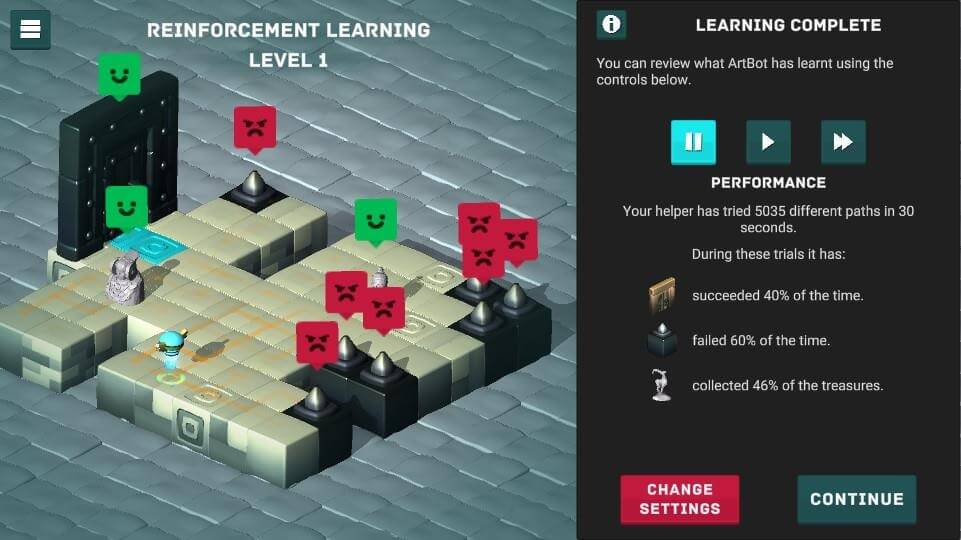
The mini-game in ArtBot that exposes reinforcement learning parameters and reward systems to students.
Abstract: The advancement of artificial intelligence (AI) and its increased use in everyday life have exacerbated the need to understand its underlying processes, and to raise awareness about its shortcomings and faults. Consequently there has been an increased effort to teach basic concepts of AI and machine learning (ML) from an early age. Digital games have been shown to be effective as teaching and learning tools, and there are ongoing efforts to increase AI literacy through educational digital games. To this effect, this work describes the process followed to extrapolate the design of such an educational game directly from the pedagogical needs emerging from stakeholders. Seven focus groups and workshops were conducted in Greece, Malta and Norway, with 55 teachers, researchers, practitioners and policy-makers, and 22 primary and secondary education students in total. These workshops identified seven goals which informed the design of a game for AI literacy called ArtBot. The game design process and the final interface and gameplay loop of ArtBot are explained in relation to these goals. The game was subsequently deployed across a variety of platforms, to enable dissemination to a broad audience in classrooms and elsewhere. The game was part of the tools developed in the framework of the LearnML Erasmus+ project. A preliminary online survey was used to gauge how well the game was received by teachers and students, with an overall positive result. A longer-term data collection of the game usage statistics has been initiated and will be analysed over the course of the game dissemination.
in Proceedings of the European Conference on Games Based Learning, 2021. BibTex
Learn to Machine Learn: Designing a Game Based Approach for Teaching Machine Learning to Primary and Secondary Education Students
Iro Voulgari, Marvin Zammit, Elias Stouraitis, Antonios Liapis and Georgios N. Yannakakis

The mini-game in ArtBot that exposes machine learning parameters and input formats to students.
Abstract: With the ubiquitous role of Artificial Intelligence (AI) in everyday applications such as smartphones and social media, children need digital literacy skills to navigate the digital world, critically view, and reflect on the social and ethical implications of the design and architecture of AI systems. To address this increasing need for AI literacy skills, particularly for younger students, this paper presents the rationale of the LearnML project which aims to develop a framework and game-based educational material for promoting AI literacy among primary and secondary education students. We also describe the design and initial assessment of the game "ArtBot", developed as part of the LearnML project. We review existing literature, discuss the educational game design and development of "ArtBot" and describe the initial feedback of students and teachers. Our goal is to provide insights and suggest guidelines for the implementation of game-based learning environments for supporting AI literacy skills of students.
in Proceedings of the ACM Interaction Design and Children (IDC) conference, 2021. BibTex
Reliving the Experience of Visiting a Gallery: Methods for Evaluating Informal Learning in Games for Cultural Heritage
Kalliopi Kontiza, Antonios Liapis and Catherine Emma Jones
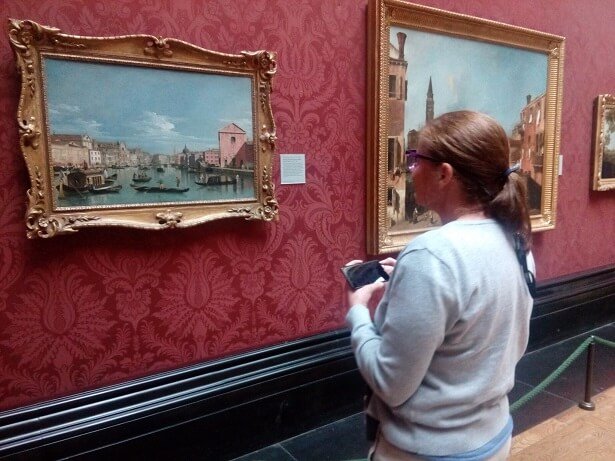
The CrossCult mobile application is evaluated at the National Gallery using the REMIND protocol.
Abstract: When evaluating the effectiveness of gamified app experiences in cultural heritage venues in terms of informal learning outcomes, a core challenge is the complexity involved in assessing intangible measures such as visitors' appraisal of artwork. A comprehensive summary of the literature for conducting museum visitor evaluations is needed in order to understand how to measure the impact of gamification on user engagement, and the enhancement of the cultural heritage experience on learning. This paper first reviews related literature regarding the application of intrusive versus non-intrusive user evaluation methods, focusing on the REMIND protocol for conducting experiments with museum visitors. We relay our findings when applying the REMIND protocol in four gamified cultural heritage applications in the CrossCult project. Focusing on the assessment of informal learning in an application specifically designed for the visitors of the National Gallery of London, the paper concludes with recommendations, challenges, and future steps in evaluating games for cultural heritage.
in Proceedings of the Foundations of Digital Games Conference, 2020. BibTex
Djehuty: A Mixed-Initiative Handwriting Game for Preschoolers
Jean Michel A. Sarr, Georgios N. Yannakakis, Antonios Liapis, Alassane Bah and Christophe Cambier
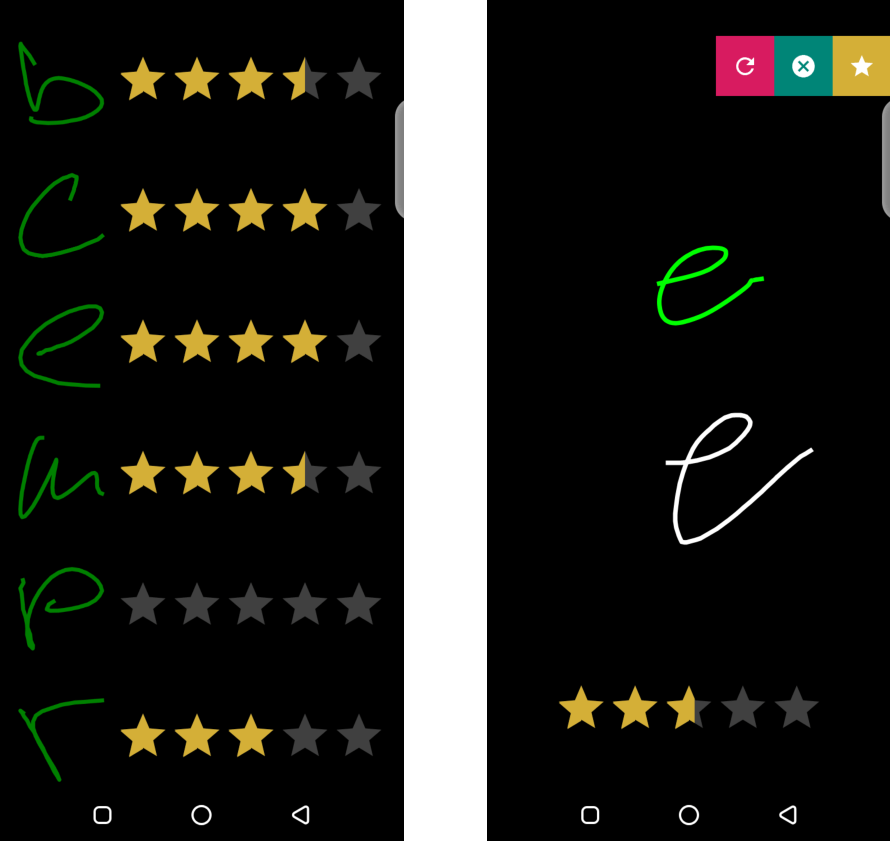
Screenshots of learners' interaction with Djehuty. Left: letter selection, showing the learner's highest score per letter. Right: the computer generates and animates a letter sample (in green), the user draws (in white) and presses the yellow "star" button to receive a score in real-time.
Abstract: Learning to read and write is a fundamental right and a necessary skill for the personal, cultural, and economic development of people and their societies. However, children of developing countries, such as sub-Saharan areas, are currently at a greater risk of illiteracy. The current penetration of mobile technologies and the internet in sub-Saharan rural areas, however, offers a unique opportunity for tackling the challenge of literacy at a large scale. Motivated by the current shortage of preschool teachers for training handwriting in a personalised manner, this paper discusses the design of Djehuty, an educational gamified environment for preschoolers. Djehuty is equipped with an artificial intelligence module which generates a style of handwriting and suggests handwriting paths to the child in a mixed-initiative manner. The paper presents the key elements of the game prototype.
in Proceedings of the Foundations of Digital Games Conference, 2020. BibTex
Modelling the Quality of Visual Creations in Iconoscope
Antonios Liapis, Daniele Gravina, Emil Kastbjerg and Georgios N. Yannakakis
Network architecture for late multimodal fusion of icons' visuals and summary statistics.
Abstract: This paper presents the current state of the online game Iconoscope and analyzes the data collected from almost 45 months of continuous operation. Iconoscope is a freeform creation game which aims to foster the creativity of its users through diagrammatic lateral thinking, as users are required to depict abstract concepts as icons which may be misinterpreted by other users as different abstract concepts. From users' responses collected from an online gallery of all icons drawn with Iconoscope, we collect a corpus of over 500 icons which contain annotations of visual appeal. Several machine learning algorithms are tested for their ability to predict the appeal of an icon from its visual appearance and other properties. findings show the impact of the representation on the model's accuracy and highlight how such a predictive model of quality can be applied to evaluate new icons (human-authored or generated).
in Proceedings of the 8th International Games and Learning Alliance Conference. Springer, 2019. BibTex
A Participatory Approach to Redesigning Games for Educational Purposes
Stamatia Savvani and Antonios Liapis
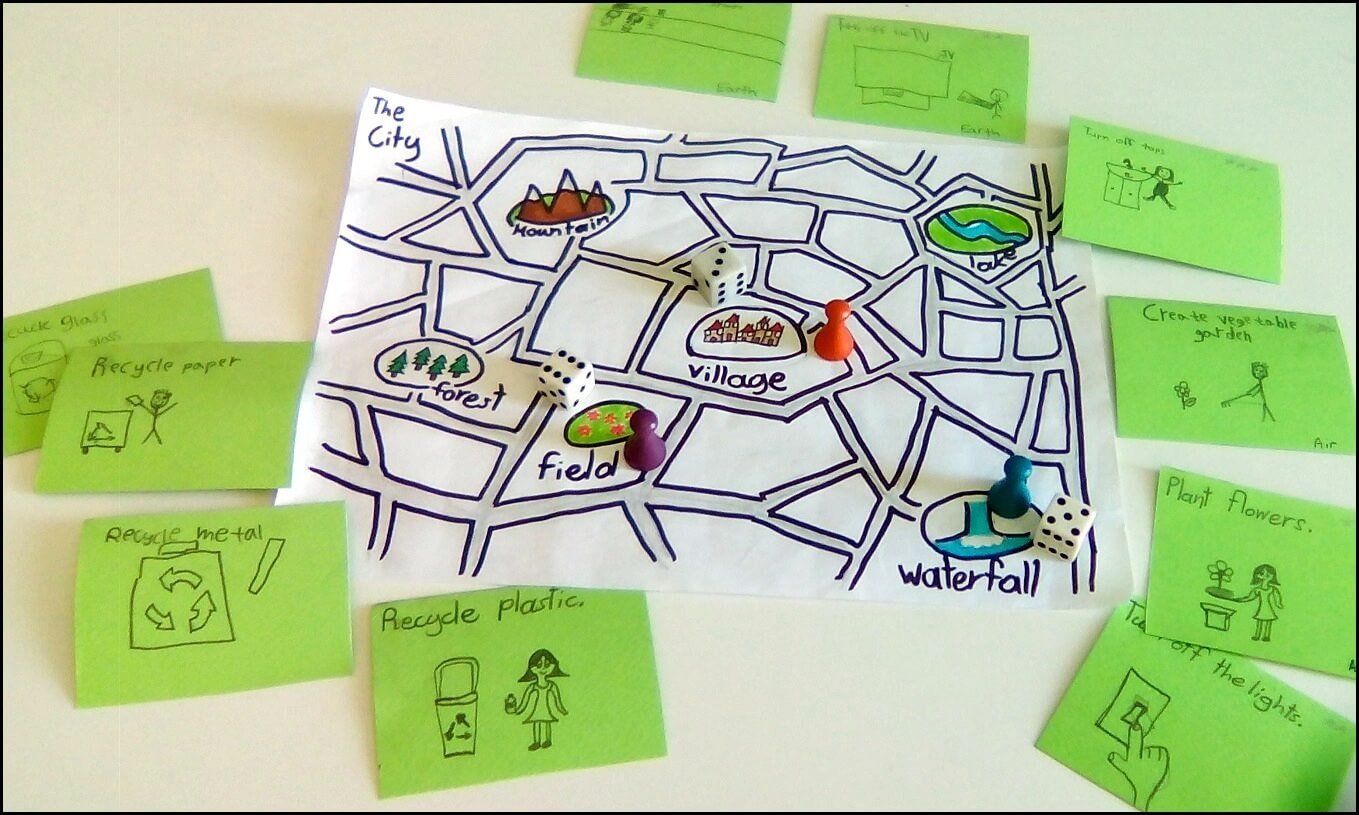
A redesigned version of Pandemic, made for (and by) an English Language class.
Abstract: Even though games designed for educational purposes can be motivating, they usually shelter dated pedagogies, passive learning procedures, and often overlook learners' creativity. In an effort to reinforce the active participation of learners in games, this paper presents a participatory process in which students and teachers are involved in game design. The proposed process concerns redesigning existing commercial games into educational ones and includes establishing the learning goals, identifying appropriate commercial games, adapting the rules and context, crafting and playtesting the game. Using language learning as one application of this process, the paper presents how three well-known tabletop games were redesigned in a foreign language classroom with elementary and intermediate English language learners. The benefits that underlie the process concern students' active participation, boosting their problem-solving skills, and engaging them in creative learning.
in Proceedings of the 8th International Games and Learning Alliance Conference. Springer 2019. BibTex
Capturing the Virtual Movement of Paintings: A Game and A Tool
Kalliopi Kontiza, Antonios Liapis and Joseph Padfield
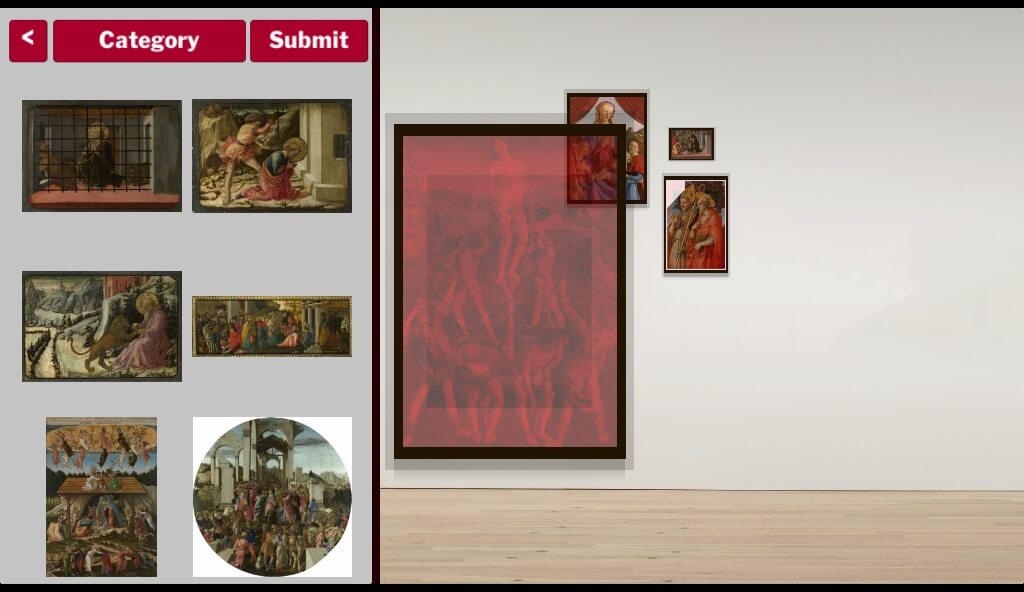
Screenshot of the virtual gallery creation game, where players add paintings to a virtual wall and create their personalized walls.
Abstract: This paper presents a virtual gallery creation game that has been designed for the National Gallery of London, as part of the CrossCult project, with a multi-purpose goal. For visitors, the game allows users to virtually move paintings around, reflecting on their visit through gamification, while creating and curating their own virtual galleries. For National Gallery staff, the application allows them to simply visualise planned exhibitions and to accurately record the positions of paintings when they are moved or re-positioned. This paper describes the game's underlying structure, designed to serve both as an expert tool and as a game, and discusses the results obtained from initial experiments with end-users. Some preliminary conclusions can be drawn regarding the extent to which the application allows the end users to reflect on the National Gallery collection while creating and curating their own virtual galleries.
in Proceedings of the Digital Heritage International Congress (DigitalHeritage), 2018. BibTex
Board Game Prototyping to Co-Design a Better Location-Based Digital Game
Catherine Emma Jones, Antonios Liapis, Ioanna Lykourentzou and Daniele Guido
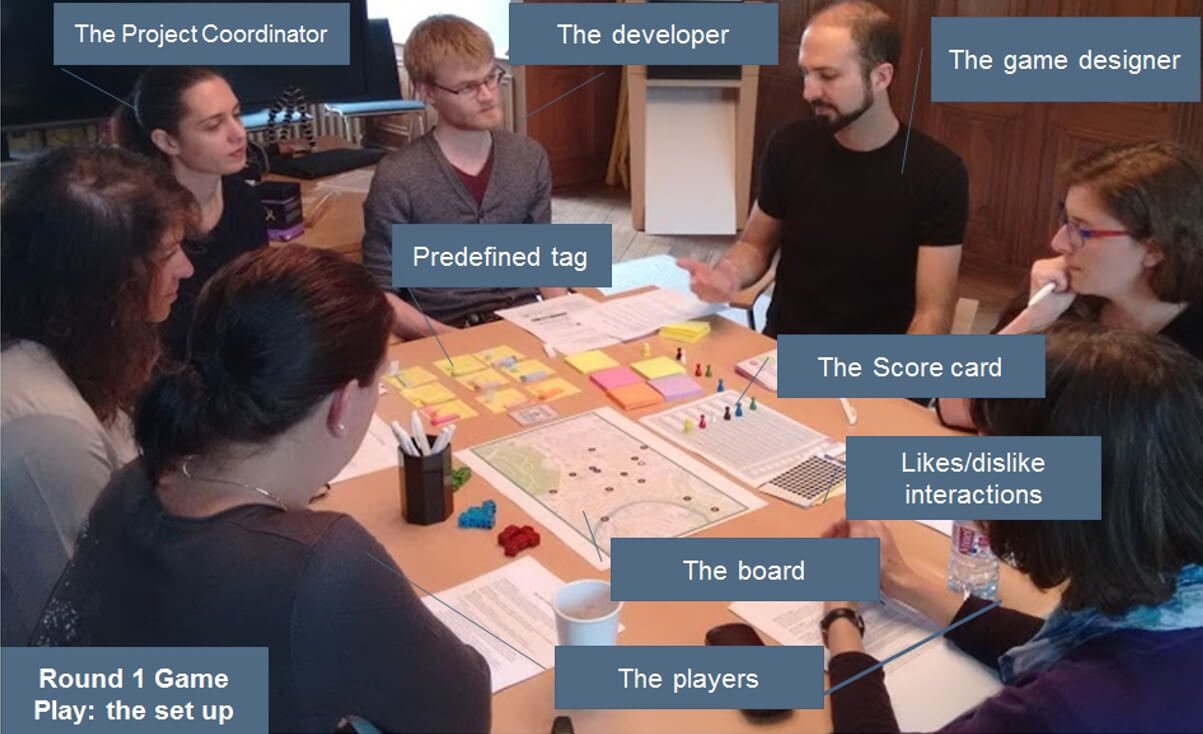
first play test of a board game prototype that partially simulated interactions within a location-based digital game.
Abstract: In this case study we describe the iterative process of paper prototyping, using a board game, to co-design a location-based mobile application. The end goal of the application is to motivate reflection on historical topics about migration. The board game serves to capture the core concerns of this application by simulating movement through the city. Three play tests highlighted the users' interest and issues with the historical content, the way this content is represented, and the players' responses to the interactions and motivating mechanisms of the application. Results show that the board game helped capture important design preferences and problems, ensuring the improvement of our scenario. This feedback can help reduce development effort and implement a future technology prototype closer to the needs of our end users.
In Proceedings of the CHI Conference Extended Abstracts on Human Factors in Computing Systems, 2017. BibTex
Mixed-initiative Creative Drawing with webIconoscope
Antonios Liapis
Example icons created by webIconoscope, seen through the voting gallery which allows users to guess which concept (of three) each icon represents, as well as rate its general appeal.
Abstract: This paper presents the webIcononscope tool for creative drawing, which allows users to draw simple icons composed of basic shapes and colors in order to represent abstract semantic concepts. The goal of this creative exercise is to create icons that are ambiguous enough to confuse other people attempting to guess which concept they represent. webIcononscope is available online and all creations can be browsed, rated and voted on by anyone; this democratizes the creative process and increases the motivation for creating both appealing and ambiguous icons. To complement the creativity of the human users attempting to create novel icons, several computational assistants provide suggestions which alter what the user is currently drawing based on certain criteria such as typicality and novelty. This paper reports trends in the creations of webIcononscope users, based also on feedback from an online audience.
In Proceedings of the 6th International Conference on Computational Intelligence in Music, Sound, Art and Design (EvoMusArt), vol. 10198, LNCS. Springer, 2017. BibTex
Motivating Visual Interpretations in Iconoscope: Designing a Game for Fostering Creativity
Antonios Liapis, Amy K. Hoover, Georgios N. Yannakakis, Constantine Alexopoulos and Evangelia V. Dimaraki
The drawing interface of Iconoscope, where a user creates an icon with colorful shapes to represent a word-concept shown at the top left corner.
Abstract: This paper introduces Iconoscope, a game aiming to foster the creativity of a young target audience in formal or informal educational settings. At the core of the Iconoscope design is the creative, playful interpretation of word-concepts via the construction of visual icons. In addition to that, then game rewards ambiguity via a scoring system which favors icons that dichotomize public opinion. The game is played by a group of players, with each player attempting to guess which of the concepts provided by the system is represented by each opponent's created icon. Through the social interaction that emerges, Iconoscope prompts co-creativity within a group of players; in addition, the game offers the potential of human-machine co-creativity via computer-generated suggestions to the player's icon. Experiments with early prototypes, described in this paper, provide insight into the design process and motivate certain decisions taken for the current version of Iconoscope which, at the time of writing, is being evaluated in selected schools in Greece, Austria and the United Kingdom.
in Proceedings of the 10th Conference on the Foundations of Digital Games, 2015. BibTex